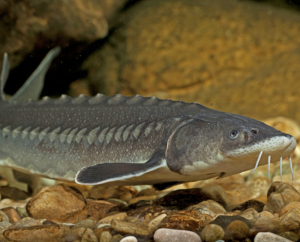Ironically, the very industry that caused the decline of so many sturgeon species is now playing a key role in their comeback.
諷刺的是,導(dǎo)致多種鱘魚(yú)數(shù)量減少的產(chǎn)業(yè)如今也在鱘魚(yú)的回歸中發(fā)揮重要作用。
At his family's sturgeon farm outside of Milan, Italy, Sergio Giovannini stands on a metal grille above the water and points beneath his feet to a fish named Cavallo.
塞吉?dú)W·喬凡尼尼的家族所經(jīng)營(yíng)的鱘魚(yú)養(yǎng)殖場(chǎng)位于意大利米蘭郊外,他站在養(yǎng)殖場(chǎng)水面上方的金屬格柵上,指著腳下一條名叫卡瓦洛的魚(yú)。
Today most of the world's caviar is produced in aquaculture facilities like this one -- farms that sturgeon advocates hope can play a part in saving many European caviar species.
目前全球大多數(shù)魚(yú)子醬都在這類水產(chǎn)養(yǎng)殖機(jī)構(gòu)中制作,鱘魚(yú)保護(hù)倡議人士希望這些養(yǎng)殖場(chǎng)能出一份力,幫助挽救多種用于制作歐洲魚(yú)子醬的鱘魚(yú)。
The Giovannini family raises 300,000 Adriatic, Russian, sterlet, and stellate sturgeons to sell on the global market. Most of these fish will be sold for caviar and meat. Not Cavallo.
喬凡尼尼家族養(yǎng)殖了30萬(wàn)條納氏鱘、俄羅斯鱘、小體鱘、閃光鱘,在全球市場(chǎng)上銷(xiāo)售。這些魚(yú)大多會(huì)制成魚(yú)子醬和鱘魚(yú)肉出售,但不包括卡瓦洛。
Everyone had assumed Cavallo, which was sleek and jumped like a stallion, was a male -- hence the masculine name.
卡瓦洛的身體線條流暢,跳起來(lái)就像公馬一般,大家原本都以為它是雄魚(yú),因此幫它取了一個(gè)男性化的名字。
But in 2020, after the family moved Cavallo from a site fed by spring water to the farm's river-fed tanks, Cavallo produced eggs for the first time. She was around 50 years old.
但在2020年,喬凡尼尼家族將卡瓦洛從一處以泉水注入的地點(diǎn)移到養(yǎng)殖場(chǎng)以河水注入的水缸之后,卡瓦洛居然第一次產(chǎn)卵,當(dāng)時(shí)它已經(jīng)大約50歲了。
Now she's contributing those eggs to the future of the species.
如今它產(chǎn)下的卵能為鱘魚(yú)的未來(lái)做出貢獻(xiàn)。
"We give this lady sturgeon river water, and after three, four years, miracles happen," Giovannini says.
喬凡尼尼說(shuō):“我們?yōu)檫@只鱘魚(yú)女士提供河水,結(jié)果三、四年后,奇跡發(fā)生了。”
It is also something of a miracle that Cavallo and the other Adriatic sturgeons on the farm exist at all.
卡瓦洛和其他納氏鱘能在養(yǎng)殖場(chǎng)中存活,也算是一項(xiàng)奇跡。
Sergio's father, Giacinto, purchased Cavallo and around 60 other Adriatic sturgeons from fishermen on the Po River and its tributaries in the mid-1970s, before Sergio was born.
20世紀(jì)70年代中期,塞吉?dú)W的父親賈辛托向波河及其支流的漁民買(mǎi)下卡瓦洛和其他約60只納氏鱘,當(dāng)時(shí)塞吉?dú)W尚未出生。
They were among the last wild Adriatic sturgeons captured alive; the species was designated by the IUCN as critically endangered, and possibly extinct in the wild, in 2010.
這些鱘魚(yú)是最后一批活捉的野生納氏鱘;IUCN在2010年將納氏鱘列為極危物種,且可能已在野外滅絕。
Though Giacinto had experience breeding trout and pike, he had no idea how to breed sturgeons in captivity.
盡管賈辛托擁有繁殖鱒魚(yú)和梭子魚(yú)的經(jīng)驗(yàn),卻不知道如何在圈養(yǎng)環(huán)境中繁殖鱘魚(yú)。
He had heard the Soviets had been successfully fertilizing Caspian sturgeon species since the 1860s.
他聽(tīng)說(shuō)蘇聯(lián)人自19世紀(jì)60年代起就開(kāi)始成功繁殖里海的鱘魚(yú)。
In the 1940s, their scientists figured out how to induce ovulation with injections of pituitary hormones, and in 1969 they retrieved the eggs using laparotomies -- invasive surgeries to access the gametes, much like human cesarean sections.
在20世紀(jì)40年代,蘇聯(lián)科學(xué)家研究出如何通過(guò)注射腦下垂腺荷爾蒙來(lái)誘發(fā)排卵,而在1969年,他們成功使用開(kāi)腹手術(shù)(可獲取配子的侵入性手術(shù),很像人類的剖腹產(chǎn)手術(shù)),取出魚(yú)卵。
When Giacinto sought the Soviets' help for Adriatic sturgeons in 1978, they refused.
賈辛托在1978年求蘇聯(lián)協(xié)助繁殖納氏鱘,卻遭到拒絕。
Instead, he learned through trial and error with the assistance of French and Italian scientists.
于是,他在法國(guó)和意大利科學(xué)家的幫助下,通過(guò)反復(fù)試驗(yàn)來(lái)學(xué)習(xí)如何繁殖。
In 1988, around the time wild sturgeon fishing was largely banned, he finally succeeded using a noninvasive "stripping method," applying gentle pressure to a ripe female's abdomen to "squeeze" the eggs out of the fish. No incisions required.
1988年,也就是捕捉野生鱘魚(yú)的活動(dòng)大多受到禁止的時(shí)候,賈辛托終于使用一種非侵入性“剝離法”,對(duì)卵成熟期的雌魚(yú)腹部輕輕加壓,成功從雌魚(yú)體內(nèi)“擠出”魚(yú)卵,完全不需要手術(shù)切口。
Soon after, he distributed his first Adriatic fingerlings to conservation organizations for restocking, and then, in the 1990s, he began raising Adriatic and other species for caviar production as well.
不久后,他將第一批納氏鱘幼魚(yú)分送到保護(hù)組織放流,他自已也在20世紀(jì)90年代開(kāi)始飼養(yǎng)納氏鱘和其他種鱘魚(yú),供魚(yú)子醬生產(chǎn)之用。
It's thought every Adriatic sturgeon in the world today is descended from the breeding stock Giacinto collected in the '70s.
普遍認(rèn)為,目前世界上每一只納氏鱘都是賈辛托在20世紀(jì)70年代收集的繁殖種源的后代。

"Looking back," says Beate Striebel-Greiter, the World Wide Fund for Nature's sturgeon initiative lead, "you can say the Giovanninis have probably saved the Adriatic sturgeon."
世界自然基金會(huì)的鱘魚(yú)倡議主任貝雅特·史翠貝爾-格里特說(shuō):“回過(guò)頭來(lái)看,可以說(shuō)是喬凡尼尼家族挽救了納氏鱘。”
Experts hope these sorts of efforts can protect other species such as the Russian and sterlet sturgeons -- and belugas, the grandest, most coveted of them all.
專家希望這些保育工作能保護(hù)其他種鱘魚(yú),例如俄羅斯鱘、小體鱘,以及體型最大、最受人覬覦的黑海鰉。
Belugas came under crushing population pressure when sturgeon numbers crashed in the 20th century as a result of overfishing and dam construction.
鱘魚(yú)數(shù)量在20世紀(jì)因過(guò)度捕撈和水壩工程而急劇減少時(shí),黑海鰉面臨巨大的族群壓力。
A black-market free-for-all then flourished, with egg-bearing beluga females estimated to have fetched as much as three million dollars each.
當(dāng)時(shí)黑市交易猖獗泛濫,帶卵的雌性黑海鰉價(jià)格估計(jì)高達(dá)一條300萬(wàn)美元。
Belugas could once be found, and fished, in northern Italy. Now they are gone from Italian rivers and found only in very small numbers in the Caspian and Black Seas -- and on farms.
意大利北部原本可以找到并捕捉到黑海鰉,但如今他們已從意大利的河流中消失,僅有少量分布于里海、黑海及養(yǎng)殖場(chǎng)。
While the illegal caviar trade persists, expanding aquaculture makes it less lucrative.
盡管非法魚(yú)子醬交易仍然存在,但持續(xù)擴(kuò)張的水產(chǎn)養(yǎng)殖降低了這項(xiàng)產(chǎn)業(yè)的利潤(rùn)。
"When I kill fish with my right hand, with my left I can also be involved with conservation," says Sergio Giovannini's brother John, who, along with Sergio, continues to provide breeding stock for ongoing Adriatic sturgeon reintroduction efforts.
塞吉?dú)W·喬凡尼尼的兄弟約翰說(shuō):“我用右手殺魚(yú)的同時(shí),可以用左手參加保育工作。”他和塞吉?dú)W持續(xù)提供繁殖種源給進(jìn)行中的納氏鱘再引入工作。
From the Giovanninis, the farmed sturgeons travel by truck to caviar processor Agroittica Lombarda in the nearby industrial town of Calvisano.
養(yǎng)殖鱘從喬凡尼尼家族的養(yǎng)殖場(chǎng)出發(fā),運(yùn)送到鄰近的工業(yè)城鎮(zhèn)卡爾維薩諾給魚(yú)子醬加工商Agroittica Lombarda。
Agroittica Lombarda processes almost 31 tons of caviar each year.
這個(gè)加工商每年生產(chǎn)31噸的魚(yú)子醬。
Unlike the Giovanninis' breeding program, the caviar harvest still requires killing the fish.
不同于喬凡尼尼家族的繁殖計(jì)劃,收獲魚(yú)子醬仍然需要?dú)⑺厉\魚(yú)。
The sturgeons are unloaded into a V-shaped slaughtering trough, then moved to processing rooms where employees, clad in surgical gloves and gowns, remove the ovaries and pull out hundreds of thousands of glistening, dark eggs -- accounting for up to 25 percent of a fish's total weight -- then rinse, taste, grade, weigh, salt, pack, press, and finally can and label them for sale.
卡車(chē)上的鱘魚(yú)會(huì)送進(jìn)V型屠宰槽,接著移到處理室,穿戴外科手套和隔離衣的員工會(huì)取出卵巢并拉出數(shù)十萬(wàn)顆充滿光澤的黑色魚(yú)卵,這些魚(yú)卵占雌魚(yú)總體重將近25%,隨后魚(yú)卵會(huì)經(jīng)過(guò)沖洗、品嘗、分級(jí)、秤重、鹽腌、包裝、壓實(shí),最后裝罐并貼上標(biāo)簽準(zhǔn)備岀售。
"When you buy caviar, you don't buy the eggs of sturgeon; you buy a perception," says Paolo Bronzi, president of the World Sturgeon Conservation Society. "A luxury product, something special just for rich people. Champagne, caviar, a nice girl."
“你買(mǎi)魚(yú)子醬時(shí),買(mǎi)的不是鱘魚(yú)的卵,而是一種感覺(jué)。”世界鱘魚(yú)保育協(xié)會(huì)主席保羅·布朗茲說(shuō):“這是一種奢侈品,專為有錢(qián)人提供的食品。香檳、魚(yú)子醬、美女。”
In the grading room, one of the workers offers me a taste of ossetra caviar from the critically endangered Russian sturgeon.
在分級(jí)室里,一名工作人員讓我品嘗一口來(lái)自極危物種俄羅斯鱘的奧塞特拉魚(yú)子醬。
It's true; it tastes like abundance: birth, salt, sea, life.
布朗茲說(shuō)得沒(méi)錯(cuò),這口魚(yú)子醬滋味很豐富:誕生、鹽、海洋、生命。












